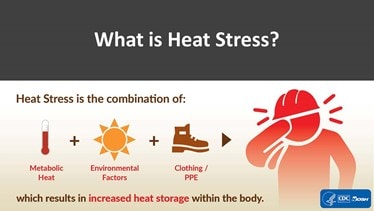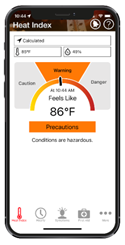Working in Heat

Heat stress can affect many outdoor and indoor workers. To prevent heat-related illnesses (HRI) and injuries, employers should develop and use a comprehensive heat-related illness prevention program at the workplace.
In occupational settings, heat stress is the combination of the heat your body produces (metabolic heat), environmental factors (for example, temperature and humidity), and clothing and personal protective equipment (PPE). While many workers need to wear PPE for protection from workplace chemical, physical, and biological hazards, PPE can increase the risk for HRIs. PPE can often alter the rate and amount of heat exchange between the skin and air. For example, impermeable materials used for protection against chemical hazards can be very hot to wear, as they trap heat close to the skin and prevent sweat evaporation.
Below are some elements for addressing heat stress that need to be included in workplace HRI prevention programs.
Control of Heat Stress
Employers should reduce workplace heat stress by implementing engineering and work practice controls.
Engineering controls might include those that:
- Increase air velocity (if air temperature is below 95°F).
- Use reflective or heat-absorbing shielding or barriers.
- Reduce steam leaks, wet floors, or humidity.
Work practice controls include the following:
- Implement a buddy system and routinely check workers to ensure they make use of available water and shade, and they do not have symptoms of an HRI.
- Monitor the weather.
- Limit time in heat and/or increase rest time in a cool environment.
- Increase the number of workers per task.
- Require workers to conduct self-monitoring.
- Implement a heat alert program when a heat wave is likely.
Training
Employers need to provide training before hot work begins, and tailor the training to cover worksite-specific conditions.

Workers and supervisors should be trained on:
- Recognition of the symptoms of HRIs.
- First aid.
- HRI risk factors.
- Importance of acclimatization.
- Importance of reporting HRI symptoms.
Additionally, supervisors should be trained on:
- How to implement appropriate acclimatization.
- Procedures for when a worker has symptoms of a HRI.
- How to monitor weather reports and respond to advisories (such as with the OSHA-NIOSH Heat Safety Tool App).
- How to monitor and encourage adequate fluid intake and rest breaks.
Acclimatization
Workers become acclimatized to heat when they gradually work for longer periods in a hot environment. Benefits of acclimatization include less strain to the heart and vital organs, improved sweating (higher volume, earlier onset), and increased ability to perform physical tasks in the heat.
Employers must make certain that workers acclimatize by gradually increasing the time they work in hot conditions over 7-14 days.
New Workers Exposure Schedule
- Day 1 – Exposures to heat should be less than 20% of usual work duration.
- Increase a maximum of 20% per day after Day 1.
Experienced Workers Exposure Schedule (for those returning after an absence of 1 week or more)
- Day 1 – 50% of usual work duration; Day 2 – 60%; Day 3 – 80%; Day 4 – 100%
Hydration
Employers should provide appropriate hydration.
- Water should be cool and near the work area.
- Individual drinking cups should be provided.
- Encourage workers to hydrate themselves.
Workers should drink an appropriate amount to stay hydrated.
- If in the heat <2 hours and involved in moderate work activities, then drink 1 cup (8 oz.) of water every 15–20 minutes.
- If experiencing prolonged sweating lasting several hours, then drink sports drinks containing balanced electrolytes.
- Avoid alcohol and drinks with high caffeine or sugar.
- Generally, fluid intake should not exceed 6 cups per hour.
Rest Breaks
Employers should ensure and encourage rest and hydration breaks.
- Permit breaks when a worker feels discomfort.
- Assign new workers lighter work and longer, more frequent breaks.
- Shorten work and increase rest periods:
- As temperature, humidity, and sunshine increase.
- When there is no air
- If protective clothing or PPE is worn.
- For heavier work.
While these basic recommendations can be applied to many different workplaces, if heat stress is a hazard at your workplace, consult with a safety and health professional, and review the full recommendations provided in the NIOSH Criteria for a Recommended Standard: Occupational Exposure to Heat and Hot Environments.
More Information
- NIOSH Heat Stress
- NIOSH Criteria for a Recommended Standard: Occupational Exposure to Heat and Hot Environments
- OSHA-NIOSH Heat Safety Tool App
- OSHA Heat Illness Prevention Campaign
Printable Resources
- Protect Your Workers from Heat Stress (Infographic)
- Prevent Heat-Related Illness (poster)
- Fast Facts: Protecting Yourself from Heat Stress
- Preventing Heat-related Illness or Death of Outdoor Workers
- Protecting Workers from Heat Illness
- Acclimatization Fact Sheet
- Hydration Fact Sheet
- Work/Rest Schedules Fact Sheet
